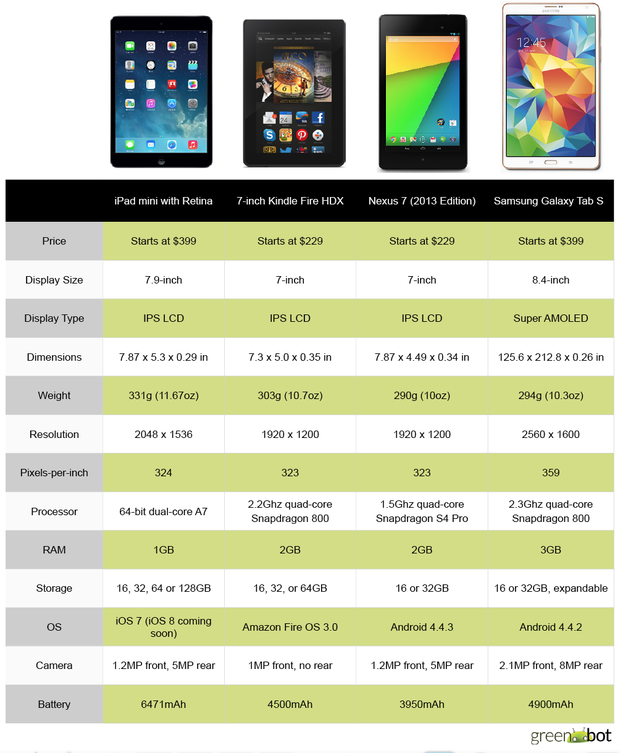Before last week’s debut of the Galaxy Tab S, Samsung didn’t offer too many 7- 8-inch sized tablets that were considered serious competitors among some of the top contenders, most notably ’s Nexus 7 Apple’s id mini.
Based on our initial impressions, Samsung’s new flagship 8.4-inch Galaxy Tab S might make the company the reining champ of the mid-sized tablet world with its quad-core processor high res Super AMOD screen. ’ve yet to publish a full-blown review of the product, but we can take a peep at those specification sheets see how it stacks up to other tablets in its class.
 Homnick
Homnickwerful specs for a reasonable price
ok at the chart. Now look at your hs. Go back to the chart. You could have a quad-core powerhouse in your hs very soon. Of the popular tablets out on the market right now, Samsung’s has the most RAM, which should help smooth out multitasking when you’re switching between apps running multiple apps at the same time.
The Galaxy Tab S also offers the potential for the most storage of the four tablets listed, though not right out of the box. ile Apple’s id mini with Retina Display is available with 128GB of storage space, it’s a whopping $699 for that particular model. Samsung’s tablet starts at $399, but that gives you access to expable storage. The deal gets better when you factor in either a 64GB or 128GB microSD card you can pop in.
A super-saturated screen
In previous reviews, we’ve noted how exhausting it can be to stare at Samsung’s high-contrast, highly saturated Super AMOD displays, but it’s a welcome change compared to the other choices on the market. Most tablet makers stick with I D displays, but the benefits of the Super AMOD means you’ll not only see the blackest blacks, but you’ll see crisper images. It’s also more power efficient, coupled with the Galaxy Tab S’s massive 4,900mAh battery pack, you’ll be able to watch movies for a really long time.
It’s bigger, but not overwhelming
Of the four tablets featured here, Samsung’s Galaxy Tab S is the biggest in size, but not overwhelmingly so. Still, Amazon’s 7-inch Kindle Fire HDX is the more portable of the bunch. I noted in the last tablet face-off with the Nexus 7 that for those who more interested in reading perusing social networking, the HDX is the better choice. In this particular case, a device like the Galaxy Tab S might be overkill, unless you’re addicted to watching video on the way home.
It’s not stock
Android purists will likely overlook that the id 7-inch Kindle Fire HDX are featured in the chart above instead take into consideration the fact that last year’s Nexus 7 is not only considerably cheaper, but that it also runs a stock version of Android 4.4.3. Samsung’s Galaxy Tab S, on the other h, features its Touchz overlay on top of Android 4.4.2. Updates will be frequent for a while, but you’ll have to wait for Samsung to make them available rather than . Samsung also packed its Tab S with a whole host of software you can’t just dump.
On the other h, consider the fact that has said it will only support its Android devices for up to 18 months, the second-generation Nexus 7 is reaching its expiration point. And with Android’s open source nature, you could always root the Galaxy Tab S have fun installing custom ROMs.
















